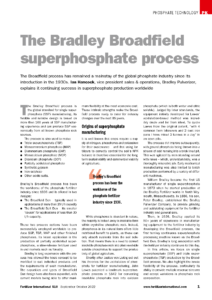
The Broadfield process has remained a mainstay of the global phosphate industry since its introduction in the 1930s. Ian Hancock, vice president sales & operations at Bradley Pulverizer explains its continuing success in superphosphate production worldwide, including:
• Origins of superphosphate manufacturing
• Making SSP and TSP
• Phosphate acidulation in the Broadfield Den
• Operational considerations
Fill out the form below to download the full article as published by BCInsight Ltd in Fertilizer International magazine, Sept|Oct 2022, issue 510, pp. 31-35
